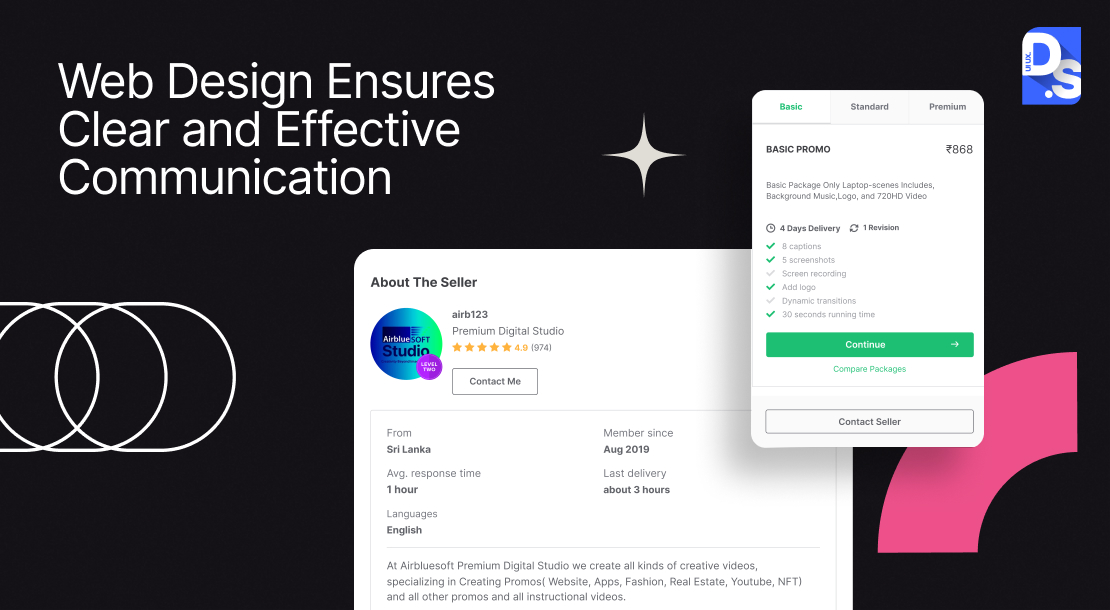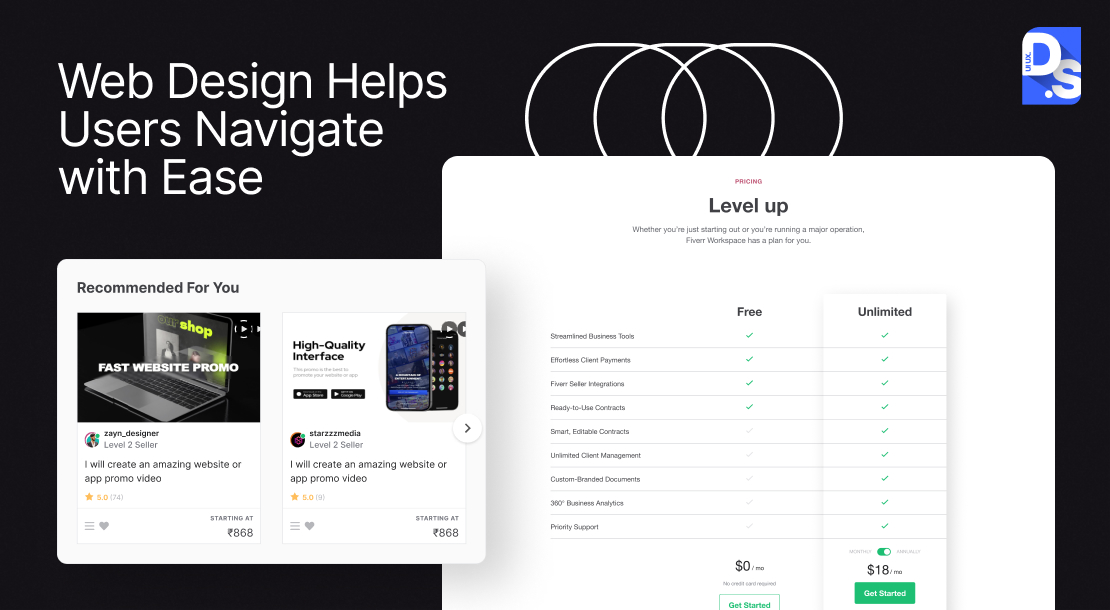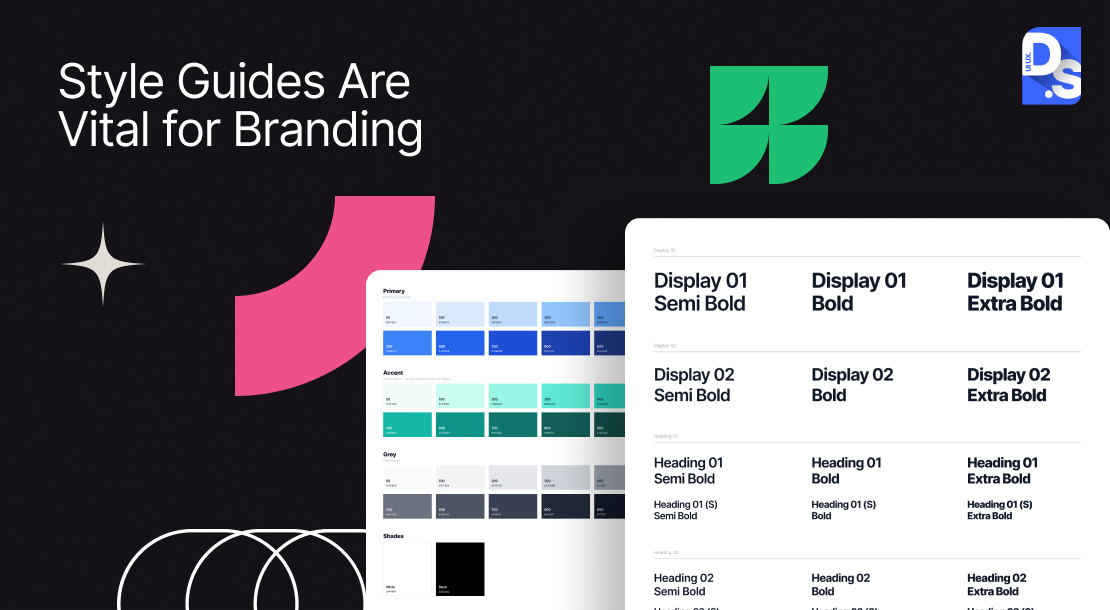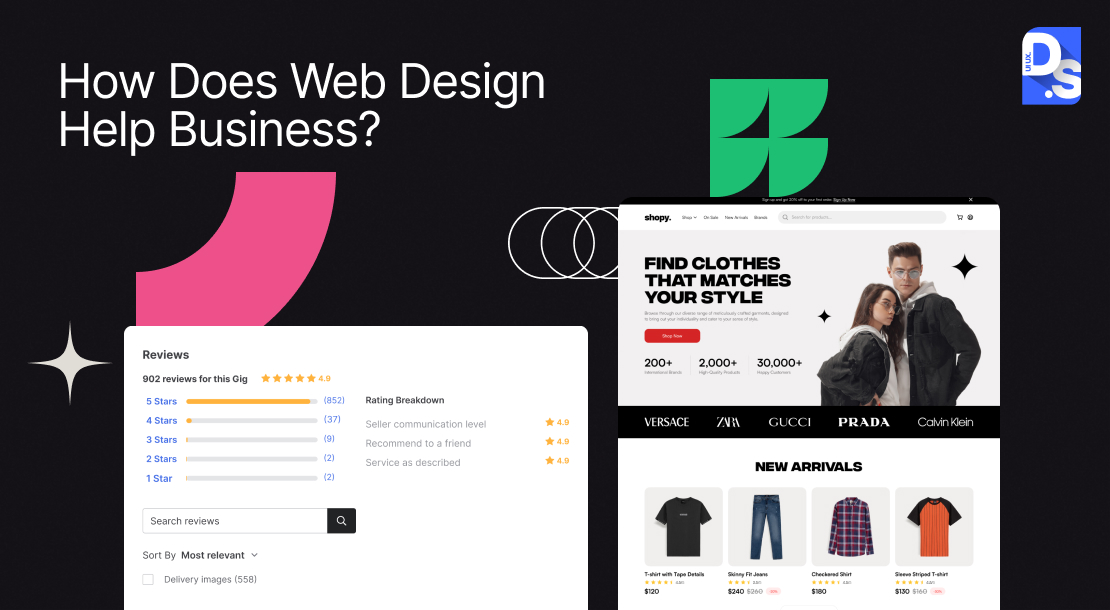Why Web Design Is Important & How It Helps Business
Why is web design important? Well, it all comes down to the fact that modern-day web design hinges on a user-centric approach that prioritizes usability and utility over everything. Users, after all, hold the ultimate power: their clicks (or lack thereof) dictate a website’s effectiveness.
This user-centric approach has become the gold standard for professional web design, and for good reason. By putting user needs first, experienced web designers empower users to easily find the information they seek on websites.
That is why web design plays such a pivotal role in shaping user experiences and driving business success in this day and age. But that’s not the only reason why. The importance of good web design in today’s highly competitive digital landscape cannot be overstated enough; but, we are going to try.
Let us explore why investing in exceptional web design is a strategic imperative for businesses of all sizes. Also, understand how web design helps business growth in the short and long run. But first, for clarity’s sake, here are some basic concepts.
What Is Web Design?

The evolution of websites over the past twenty years has been nothing short of remarkable. From once being static, text-centric platforms, websites have transformed into engaging, responsive, and interactive digital spaces. Web design has played a crucial role in this evolution, constantly shaping and reshaping how we experience the online world.
Web design is the art and science of planning, creating, and laying out the functionalities and visual elements of a website. Over the past two decades, this dynamic field has seen a dramatic shift from static, text-centric desktop websites to the interactive and dynamic experiences that dominate today’s mobile-first digital landscape.
The web designer’s toolkit has kept pace with this evolution. While HTML and CSS remain the foundational languages for web design and development, languages like Java, JavaScript, and Python have become increasingly important in crafting cutting-edge web experiences. This shift reflects the ever-evolving nature of web design and the constant push for innovation in building user-centric and visually compelling online environments.
Why is Web Design Important?
Here’s a breakdown of the crucial elements that define a ‘successful website’ with ‘good web design’ and why they are so important:
Ensures Clear and Effective Communication

A successful website always starts with a well-defined goal. What action do you want visitors to take – make a purchase, subscribe to a newsletter, or download a resource? Communicating this purpose clearly through visually distinct and strategically placed calls-to-action (CTAs) is a key aspect of web design.
Strategic use of CTAs (“Buy Now,” “Join Now,” etc.) tells users what action you want them to take. For example, Asana’s “Contact Us” page is minimalistic and all the attention falls on the visually appealing CTA and registration form. hideAWAY’s catchy homepage pop-up on the other hand uses peppy colors to subtly guide user actions.
There are many other ways to communicate your website’s purpose. The best ones tend to feature a lot of visuals and words like “my,” “me,” and “I” to address the user in the first person (for example, in CTAs like “Create My Account” or “Boost My Page”) instead of “your,” “you,” and “you all” (as in CTAs like Create Your Account” or “Boost Your Page”). Using first-person language helps create a more personal connection with visitors. This type of clear and personal messaging can boost on-site conversions by up to 90%.
Helps Users Navigate with Ease

Users should not struggle to find information on websites. Yet, they do. Why? Because many websites do not have well-structured navigation bars with clear categories and subcategories. According to a study by Baymard Institute, 82% of websites do not segregate navigation categories and subcategories into manageable chunks.
Sites with such hierarchies and navigation systems are perceived by users to be “cluttered”, or “overwhelming.” The consequences of a poor web design with poor navigation can be even more damaging than on-the-spot site abandonments: it may cause irreparable brand damage.
Now, in this context, an important question to ask is: how does web design impact content marketing? The direct answer is that proper navigation boosts content marketing efforts. Indeed well-written, informative content that resonates with your target audience is essential. But this content should be easily accessible and readable, and that’s where a great design with flawless navigation comes into play.
To truly optimize your site’s usability, it’s crucial to understand navigation UX design, including its various types and best practices. By doing so, you can implement these strategies effortlessly on your website, ensuring that your audience can easily find and engage with your content. This approach not only enhances user experience but also amplifies the effectiveness of your content marketing strategy.
Responsive Web Design Caters to Mobile Users

Mobile devices contribute to over 60% of all web traffic in 2024. In some countries, that figure is even higher. For example, in India, over 80% of web traffic comes from mobile devices. Websites must adapt seamlessly across various devices (smartphones, tablets, desktops) ensuring a positive user experience regardless of the viewing platform.
Given these statistical data, the next question is: why responsive web design is important? A well-executed responsive design, often developed with the help of a responsive website design company, guarantees proper scaling for each device. This not only prevents issues like distorted layouts or clumsy navigation but also helps companies retain visitors and build a stronger brand image.
Style Guides Are Vital for Branding

Every website needs a style guide: the foundation of its visual language, color schemes, typography, formatting, and overall brand aesthetics. Style guides streamline website development and content creation by providing a central reference point for all team members. They ensure brand consistency across all pages and help facilitate cohesive and memorable user experiences.
Website Visuals Keep Visitors Engaged

Visual elements can significantly enhance engagement and break up text-heavy content. Images and videos (when incorporated strategically) can complement the content, enhance its clarity, and help users obtain a deeper understanding of the offering.
Page Speed Optimization Keeps the Site Accessible
A website’s loading speed directly impacts user experience. According to a 2023 survey by GoodFirms, 88.5% of users think that slow loading times are the number one reason they abruptly abandon websites. Optimizing website code, compressing images, and ensuring minimal server response times are crucial for achieving fast loading speeds and avoiding such a high abandonment rate. Web designers always prioritize site speed optimization.
How Does Web Design Help Business?

Now that we know what good web design is and why it is so important, let us try to decode how web design helps business growth. To do that, let us turn to the users: which website experiences are they willing to spend money on? Well, a study by Adobe revealed that nearly 59% of Internet users prioritize browsing visually appealing and well-designed websites.
This preference translates directly to user trust and a willingness to engage with the brand. For these users, a beautiful and well-designed website fosters a sense of security and legitimacy, making them more receptive to conversions, whether it is a purchase, signup, or download.
Of course, other web users care little about how a website looks. They prioritize functionality above all else. For them, a website’s usability and clear information architecture take center stage. If a website is functional, reliable, and allows users to find what they need effortlessly, they’re more likely to convert, even with a more basic design.
This highlights the critical role web design plays across all business models and all user segments. It is a strategic tool with an immeasurable impact on business growth. This is particularly true for businesses operating entirely online. For them, every web design detail – from intuitive navigation to responsive design – matters a lot.
A single broken link, an oddly sized button, or a jarring font choice can lead to user frustration and lost conversions. Here are some other demonstrable ways web design influences various stages of the business lifecycle:
Impacts First Meeting with Potential Customer
Web design makes or breaks first impressions. In today’s digital landscape, a website is often the first touchpoint for potential customers. A study by Research Gate claims that a staggering 94% of these ‘first impressions’ of websites are design-related. This underscores the critical role web design plays in shaping brand perception and influencing user behavior right from the jump.
Users judge a business within seconds, and a poorly designed site deters them from exploring further. This translates to lost leads and missed opportunities for conversion. Web design also shapes how users perceive your brand and customer service philosophy. A high-quality website projects an image of a forward-thinking and welcoming company that values its customers.
Plus, modern web design embraces inclusivity. Design techniques like clear and consistent navigation, high-contrast color schemes (for optimal readability), and alt text for images make the site accessible to more users, including users with visual impairments.
Makes the Website More Discoverable to New Potential Users
Several web design elements directly impact your website’s discoverability in search engines. On-page SEO fundamentals, like clear content structure and keyword usage, play an essential role in how search engines crawl and index your website. Failing to optimize these aspects from the outset hinders your long-term visibility.
The same goes for mobile-first indexing: a recent shift by Google that prioritizes the mobile version of your website for ranking purposes. A well-designed mobile first design experience ensures efficient indexing by search engines, which directly affects your search visibility and your ability to be ‘discovered’ by new audiences via search engines.
Builds Brand Identity and Trust with Your Audience
Through all the web design elements that visually represent your company’s values, mission, vision, etc., on your site, you get to foster brand recognition and cultivate customer loyalty. Once that trust is built, persuasive design elements, like strategically placed calls-to-action (CTAs), forms, and buttons, nudge those same visitors toward desired actions.
At its core, trust is the bedrock of any successful business relationship. A poorly designed website, riddled with outdated information or clunky navigation, signals a lack of professionalism and can quickly erode trust.
Imagine a potential client considering a significant investment in your manufacturing company. An unprofessional website design would not inspire confidence; they would likely seek out a competitor with a more trustworthy digital presence.
On the contrary, a well-designed website acts as a trust signal. Clean layouts, a modern aesthetic, and seamless mobile functionality reassure visitors that they are interacting with a professional and reliable business. Web design is a strategic tool that fosters trust, drives conversions, and lays the foundation for sustainable business growth.
Your Competitors are Doing It
If you need a more in-depth explanation of how web design helps business growth, check out your competitors. Chances are, they have already heavily invested in web design. Globally, 71% of businesses (of all sizes) reported having websites of their own in 2023. In this crowded digital landscape, an outdated or poorly designed website can put your business at a significant disadvantage.
Final Take
Web design’s importance extends far beyond first impressions and conversions. A well-designed and developed website is not just a one-time impression and conversion tool; it is one of the most vital investments you can make into your brand’s future. At Design Studio, we understand the enduring value of web design. That is why our user-centric websites are built with scalability in mind. They target new markets, integrate new technologies, and keep adding value to our clients’ businesses year after year.
If you are looking to invest in quality web design, you can check out our article Tips for How to Choose a Web Design Agency to ensure you make the best choice for your business.

comments
Add comment